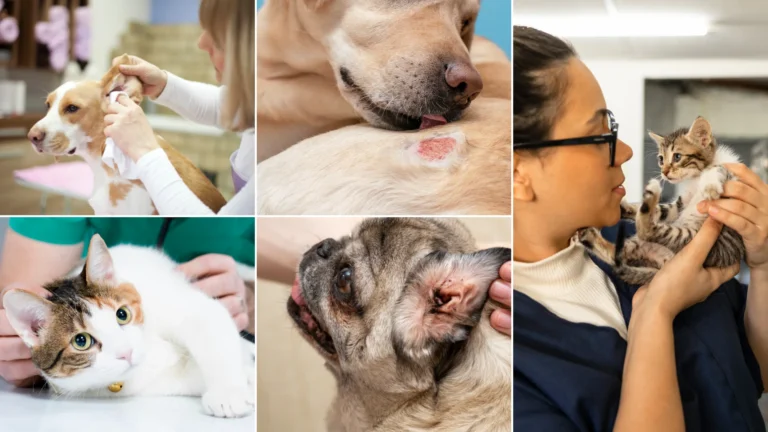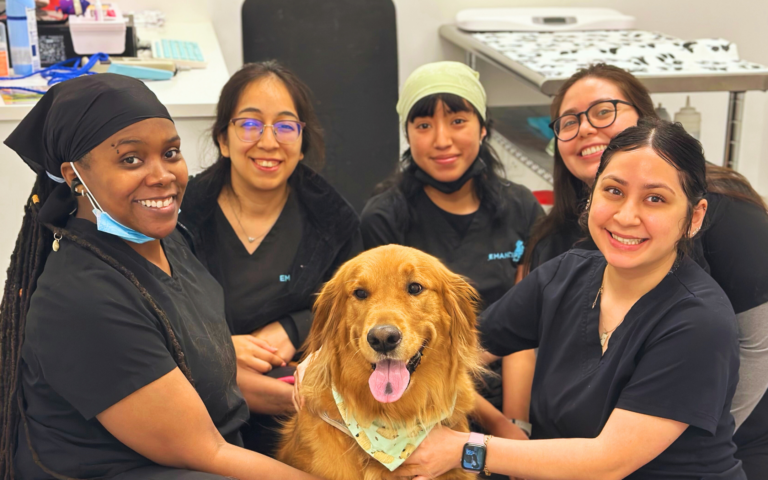Dogs and cats scratch, lick, scoot, or chew for a lot of reasons. It can be tough to nail down what’s wrong without help from a veterinarian. From allergies to bug bites to boredom, we’ll break down signs to look for and where to go (Emancipet vs. a full-service or specialty clinic) to get the care your pets need.
Fleas, Ticks, and Mites – The Big Three (or tiny three) Itch Inducers

Some of the most common causes of scratching are fleas, ticks, and mites. Although ticks are typically easy to spot (and feel), fleas are tiny and can go unnoticed for weeks. Both fleas and ticks can carry other diseases, cause pet hair loss, and can spread to people. The best plan of attack is always prevention. With a $20 office visit at Emancipet and one pill a month your pet can stay flea and tick free.
Found a tick on your pet and you’re wondering what to do? Check out our veterinarian’s tips on removing a tick safely. If you find fleas or ticks on your pet, stop in at Emancipet for affordable medicine that will kill both pests within a matter of hours and keep them away for good. Without preventative medicines, it’s a sure bet fleas and ticks will be back on your pet.
Ear mites are a parasite that’s harder to prevent. They’re passed from pet to pet but can also be picked up at the dog park or anywhere animals hang out. Mites are microscopic and need a veterinarian to tell for sure if they are your pet’s itch inducer.
If your pet has itchy ears with swelling, redness, or buildup, your vet can diagnose if it’s a parasite or an organic cause like a yeast infection. Both ear mites and ear yeast infections require medicine but are easy to treat if you catch them early. A tell-tale sign that something’s up is a funky odor coming from your pet’s ears. Take a look and a whiff – if it’s gross in there, get that pet to the vet.
Fleas, Ticks, Mites – What To Look For
- Small black granules in your pet’s fur, often called “flea dirt”
- Live or dead fleas, usually around the belly, tail, or ears
- Follow our guide on how to check for ticks
- For ear mites, smell your pet’s ears for a funky odor and look for coffee ground-like dirt, redness, brown waxy buildup, or swelling
Bottom Problems – My Pet’s Biting Their Bum
If your pet is biting at their rear end or scooting to scratch their bottom, the two most common causes of scratching are worms (we’ll get to that in a moment) or their anal glands are bothering them.
When everything’s running smoothly down there, dogs and cats empty two glands in their rear end each time they poop. The glands help dogs and cats mark their territory, using the smell as a “sign” that this is their turf. It’s also a social cue – the reason dogs sniff each other’s butts!
But a few times in a pet’s life – and more frequently for some dogs and cats – their anal glands just don’t work right, and they need help to empty them. And that my friends, is a veterinarian’s least favorite job. To be honest, it smells terrible, but it must be done! Stopped-up anal glands can lead to major infection and a lot of pain for your pet.
Don’t worry, though. Emancipet’s veterinarians can quickly tell if anal glands are causing your pet’s itchy bottom. They can treat the condition with a simple wellness check and have your pet itch-free in no time.
Worms, however, take medicine and sometimes more than one visit to cure. Cats and dogs are susceptible to many kinds of worms, especially when they’re young. But the most common are roundworms and tapeworms. Worms are so common in fact, that almost every dog and cat will be infected with them at some point in their lives – usually in their first year.
A tell-tale sign of worm infestation is a bloated belly, sometimes an itchy bum, and you may even see worms in your pet’s poop. If you suspect your pet has worms, or if you have a new puppy or kitten who hasn’t been tested, get to the vet. Worm infestations can be life-threatening in young pets. Emancipet or your full-service veterinarian can administer dewormer medicine and advise on next steps.
Worms or Glands – What To Look For
- Scooting across the floor, grass, or furniture to scratch their bottom
- Frequent bum chewing or licking
- For worms, especially in puppies and kittens, a bloated belly, worms in their poop, slow growth, or inability to gain weight
If It’s Not Pests, It Might Be Allergies

Just like humans, dogs and cats can have seasonal and environmental allergies. From their food to dust, your pets may be allergic to many of the same things YOU are allergic to. However, unlike in humans, diagnosing pet allergies can be more complicated. It’s difficult to tell what is causing an allergic reaction when you can’t talk to your pet!
But, a full-service veterinarian can help you narrow it down by listening about your pet’s habits, diet, and environment, and prescribing diet changes or medicines to rule out what’s making them itch.
The key to treating allergy issues is to get your pet to the vet before they start scratching their skin raw. Once the skin is broken, infection can take over, making the problem not only more painful for your pet, but also more expensive to treat.
Before you go to your full-service vet, be sure to 1) ask if they treat skin issues like allergies and 2) be prepared to describe your pet’s symptoms including where they’re most itchy, the severity of itchiness , how long it’s been going on for, and any at home treatment that you’ve already attempted. Don’t be afraid to be honest with your veterinarian about remedies you’ve tried at home. Exposure to chemicals like pesticides, bug sprays, or harsh detergents may need urgent treatment.
Allergies – What To Look For
- Constant licking, chewing, scratching, or rubbing eyes
- A red belly, ears, paws or between toes, red eyes
- Swelling in any of those areas
- Seasonal or environmental patterns
- Sleepless nights from chewing or scratching their skin
What’s a Hot Spot?
Hot spots are small, usually bald, irritated, and inflamed patches of skin on your pet. They typically turn up on a pet’s head, hips, paws, or chest, and feel hot to the touch – giving them the nickname “hot spots.”
Hot spots are painful for your pet and can be triggered by a whole host of stressors, from skin infections, to allergies, pests, or nervous licking. Your full-service vet can help you diagnose why the hot spot has manifested and give you a strategy on how to soothe and prevent them in the future.
Do Pets Scratch When They’re Anxious or Bored?
If your dog or cat is bored or anxious, licking, scratching, or chewing can become an obsessive outlet for them. It’s like humans nervously fidgeting or biting their nails. If you suspect your pet is nervously scratching and you’ve ruled out all potential medical causes, work to reduce whatever is stressing them out. If your cat’s scared of the coat rack, move it to the garage. Ensure they have a calm, safe space to chill out and plenty of time with their favorite person if that’s what soothes them. Your pet can’t tell you what’s wrong, so pay close attention to what makes them edgy and do your best to help them cope.
In contrast, if you think boredom is the culprit, try changing up their routine. Introduce a new toy, mental challenge, or take new routes on your walk to engage their brain. If the scratching subsides when they’re busy, you might be on the right track. Consider adding activities each week (like these fun training tips for your cat) to keep your pet working their brain and body rather than scratching.
Behavioral Scratching – What To Look For
- Obsessive licking, chewing, scratching, or rubbing a spot on the body with no obvious medical cause like fleas
- The behavior stops when stress is reduced, exercising, or playing
- In dogs, consider if their breed is known to need more activity or attention than most pets, like working breeds or dogs bred for high energy tasks
- For cats and dogs, pay particular attention to sounds, smells, other animals and stressors around the home that can cause anxious scratching
Do Pets Get Dry Skin?
Yes they do! From cold, dry weather to using harsh shampoo, the same things that dry your skin can dry your dog or cat’s skin and fur. When you bathe your pet, be sure to use a gentle shampoo and conditioner made for them. Human shampoo can have ingredients that are overly drying or leave residue that’s not safe for pets who lick their fur.
One common mistake is bathing your pet too frequently. Both cats and dogs only need a bath about every 4-6 weeks. Of course, if they get into something stinky, an extra bath won’t hurt, but keep an eye out for dry or flaky skin.
Dry Skin – What To Look For
- Bathing too frequently
- Using a soap made for humans
- Dry or cold weather
- Flaky skin or dull, brittle fur
- If you see swelling, crusting, or loss of fur, get to a vet to make sure it’s not a bigger issue, like mange which is highly infectious
Maybe It’s More Than Skin Deep – Licking and Pain
If none of these other conditions seem to fit, consider the possibility that something is making your pet’s body hurt versus itch. For instance, if you notice your dog chewing their paw, they might have a bur wedged between their toes or a splinter in their skin. If there’s nothing obvious on the surface, licking or chewing around their joints may point to internal problems – like arthritis or ligament pain. Dogs and cats will often lick their skin to try to soothe pain, even if the cause is deep down like sore joints or muscles.
Make an appointment with your full-service vet for advice if you think your pet is having joint or muscle pain. Consider looking for a vet who can provide specialty services like imaging, physical therapy, and diagnostic testing – especially for aging pets. If you’re not sure if you need a full-service vet, our Emancipet Services list offers great guidance of what our nonprofit clinics do and don’t treat.
Body Pain – What To Look For
- Focused chewing, licking, or tenderness in the joints or a particular muscle
- First check for surface issues, cuts, or bruising
- Look for swelling or feel gently for heat in the muscle or joint. If either are present, get to a full-service vet.
Conclusion & More Help
In conclusion, there is a very long list of conditions that can make your pet scratch, chew, scoot, or rub their body raw. We’ve covered the most common ones here, but if you’re still unsure why your pet is scratching, you can always stop by an Emancipet clinic for an affordable wellness exam and advice on where to go to get the specialty treatment your pet may need.
Our Healthy Pet Services are walk-in only and first-come, first-served. A physical exam about once a year is recommended. For senior pets, a physical exam twice a year or more may be necessary. That’s one of the many reasons we work to keep our prices so low.
You Can Help – Sponsor A Pet Visit
We know that a typical visit to the vet is out of reach financially for a lot of people. We’re on a mission to change that, and you can help! Every $16 Emancipet raises supports a pet in need of veterinary care.

At Emancipet, pet families can get a nose-to-tail wellness physical exam, affordable essentials like vaccinations and flea and tick medications, access to common surgeries, and guidance on addressing any abnormal findings. Visit our list of services for all the details and donate today to make vet care accessible to everyone. Thank you for your support. It means the world to us and to the people and pets we serve.
Before you go – If you enjoyed this post, you probably love pets as much as we do! Did you know that you can sponsor a pet in need each month with a Nose to Tail Team donation and receive a limited-edition tote bag? Join our Nose to Tail Team and help a pet family get the care they need each month for just $0.54 a day.






